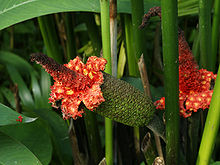Carludovica palmata
| Panama hat plant | |
|---|---|

| |
| Scientific classification | |
| Kingdom: | Plantae |
| Clade: | Tracheophytes |
| Clade: | Angiosperms |
| Clade: | Monocots |
| Order: | Pandanales |
| Family: | Cyclanthaceae |
| Genus: | Carludovica |
| Species: | C. palmata
|
| Binomial name | |
| Carludovica palmata | |
| Synonyms[1] | |
Carludovica palmata (Panama hat plant or toquilla palm) is a palm-like monocot plant. It is not a true palm. Its leaves are different from the leaves of true palms, and unlike true palms it does not develop a woody trunk. Its female flowers (which mature first) have large stigmas, and its male flowers (which mature later) have a lot of pollen. They reproduce vegetatively, because they do not produce viable seeds.
The Panama hat palm is cultivated from Central America to Bolivia. Its soft, flexible, and durable fibers are used to weave Panama hats[2] and other items.
References
- ^ Tropicos, Missouri Botanical Garden
- ^ Johnny Morris (8 June 2007). "Crowning glory of the Andes". The Telegraph. Retrieved 24 September 2010.


Wikimedia Commons has media related to Carludovica palmata.
